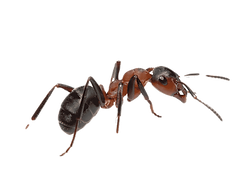What are Carpenter Ants?
Ants are some of the most successful and abundant land dwellers on the planet. With complex social organization that includes specialized castes, farming, and war, the ant family, Formicidae, in the order, Hymenoptera, comprises over 13,000 known (and more unknown) species that range throughout most terrestrial habitats. Entomologist, E.O. Wilson, once famously said, in reference to ants, “Karl Marx was right, socialism works; it is just that he had the wrong species.” One group within this family contains over 1000 species in the genus, Camponotus, collectively known as carpenter ants. And as their name implies, most species are tightly tied to wood.
Carpenter ants include the largest ants in North America, with workers reaching up to 12 mm (0.5 in) long for some species and queens up to 20 mm (~1 in). They have black or reddish bodies with the following ant family characteristics: 3 distinct body regions (head, and then thorax separated from abdomen by narrow waist), and antennae with a sharp bend. This bend is called “elbowed,” and is one way to distinguish them from termites, which have straight antennae. Common Western species, like Camponotus modoc, have long brownish-golden hairs on their abdomens. Carpenter ants differ in size, which also reflects the three different castes into which they are born. The largest is the queen, males are smaller, and the worker ants are sometimes further divided by size into majors, media, and minors (the smallest size).

Habitat
Carpenter ants typically nest in the dead or decaying wood of trees, stumps, logs, and dead branches, though some species nest in the soil. Unfortunately for us, they also nest in building material weakened by moisture. Yes, houses, sheds, and lumber piles can become targets. Colonies excavate tunnels and galleries in moist wood for one “parent” nest, but they may also have satellite nests. These satellite nests can exist in drier, sounder wood, since they contain only workers, pupae, and mature larvae; eggs need the moisture of the primary nest. While digging, they clean up as they go, pushing the resulting sawdust out of the nest. Indeed, piles of sawdust near a hole in the wood is one sign of carpenter ant infestation.
Diet and Behavior
Carpenter ants don’t actually eat the wood they excavate (unlike termites), lacking the digestive enzymes to break down cellulose. Instead, they forage on a wide variety of plant and animal materials, including sweet substances, like honeydew produced by aphids. They also eat the body fluids and proteins of both dead and live insects. Most of this foraging is at night, kept somewhat hidden by the underground tunnels they use. Carpenter ants have a painful bite, but cannot sting.

How do I get rid of Carpenter Ants?
If you are looking for pest control in the NJ area turn to the local and experienced pest professionals at Inspect Pest Control. We offer home and business owners the benefits of comprehensive pest control, superior customer service, and the peace of mind that comes with our guaranteed services. Our eco-friendly solutions solve current pest problems and keep them from returning. For home and business owners who want to protect their property from carpenter ants, contact Inspect Pest Control today!
